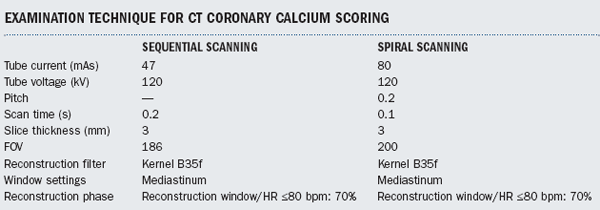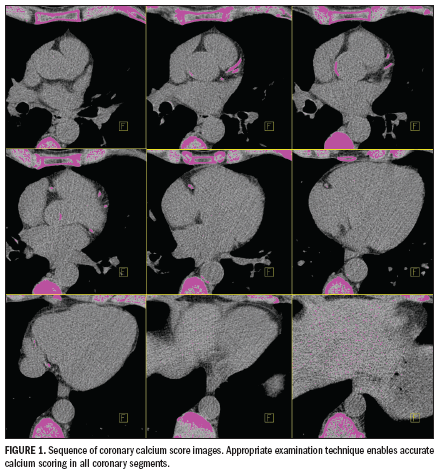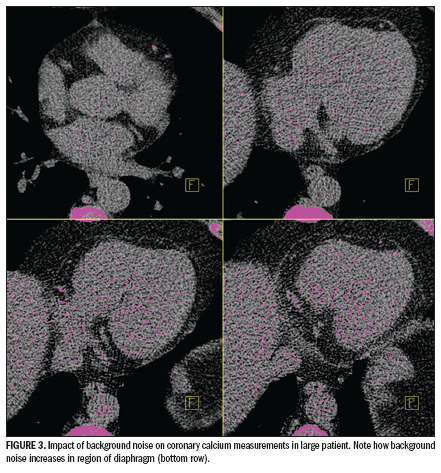Good technique preventscalcium scoring pitfalls
Coronary artery calcium measurement with cardiac CT has been used for cardiovascular risk assessment since 1990.
Coronary artery calcium measurement with cardiac CT has been used for cardiovascular risk assessment since 1990.1 The American College of Cardiology (ACC) and American Heart Association (AHA) describe calcium scoring as an independent predictor of coronary events in asymptomatic subjects. 2 Coronary artery calcium measurements can improve risk stratification by reclassifying asymptomatic individuals considered to be at intermediate risk of coronary artery disease (i.e., they have a 10% to 20% risk of a coronary event during the next 10 years) into higher or lower risk categories. Patient management can then be modified as necessary; for example, through encouragement to adopt a healthier lifestyle or introduction of medical therapy.

Recommendations published by the European Society of Cardiac Radiology and the North American Society for Cardiovascular Imaging note that a calcium score of zero will exclude most clinically relevant coronary artery disease in asymptomatic individuals.3 A zero score is associated with a low chance of relevant (≥50% reduction in diameter) coronary artery stenosis in symptomatic patients, such as those with chest pain. This is not always the case, however, because soft plaques could be causing the symptoms. Coronary CT angiography should not be ruled out in these patients.
A high coronary calcium score-for example, greater than 400 in a 50-yearold man-is associated with a very high (>90%) probability of relevant coronary artery stenosis. Immediate conventional coronary angiography should be considered in such cases.2

Several factors limit the use of calcium scoring in clinical practice. Coronary calcium is a sensitive indicator of coronary atherosclerosis, but it is not specific for the detection of relevant coronary artery stenosis (91.8% sensitivity, 55% specificity).4,5 The presence of calcium in a plaque also cannot be considered as an indicator of that plaque's biological behavior: for instance, its clinical stability or vulnerability. Many studies have additionally reported wide differences among ethnic groups in terms of the prevalence of coronary artery calcium. The clinical implications of coronary calcium scores should consequently be interpreted with caution.2,3

Studies reporting the clinical usefulness of calcium scoring are based mainly on electron-beam CT (EBCT). This modality has traditionally generated the most reproducible coronary calcium measurements. The growing availability of multislice CT in radiology departments means that this modality is increasingly replacing EBCT for the evaluation of coronary heart disease. Published reports now show that MSCT is comparable to EBCT for coronary calcium measurements.6,7 MSCT data acquisition techniques are not standardized, however.
The accuracy and reproducibility of calcium measurements made with MSCT need to be guaranteed. ACC/ AHA training guidelines have established that calcium scoring should be a formal part of cardiac MSCT training programs.8 Care must still be taken to avoid some of the pitfalls that can alter the accuracy of coronary calcium scoring with MSCT.
SCAN TECHNIQUE
We perform MSCT coronary calcium scoring with a 64-slice scanner (Sensation 64, Siemens Medical Solutions). Details of the protocol and parameters are summarized in the table (above). The parameters meet minimum requirements for coronary artery calcium scanning proposed by the AHA (Figure 1).9
Beta blockade is mandatory in patients with heart rates higher than 65 to 70 bpm to minimize the effects of cardiac motion. If the prospective gating technique (step-and-shoot) is used, data reconstruction in an early diastolic phase (40% of R-R interval) could be helpful. It can reduce interscan variability in calcium score comparing to the phase of 80% of the R-R interval, commonly used in EBCT.10
Mild abnormalities to the heart rate that occur during scanning, such as premature beats, can be compensated for manually using a spiral technique with retrospective ECG gating. Retrospective ECG gating is associated with higher radiation exposure, however, and x-ray tube modulation should be used to lower this.
Analysis of multiple reconstructions (i.e., different phases of the R-R interval) can improve the accuracy of coronary calcium measurements.11 We have found that mid- to end-diastolic reconstruction (60% to 70%) is appropriate in patients with a low heart rate (=65 bpm), whereas systolic reconstruction is preferred in patients with a high heart rate (=80 bpm).
SCORING METHODS
The Agatston method of calcium scoring is based on voxels containing calcium deposits that have an area of at least 1 mm2 and a density greater than 130 Hounsfield units. Alternatives include mass scoring and volume scoring. The mass score is based on the integration of pixels above a given threshold and is independent of slice thickness and spatial resolution.9 The volume score is the sum of the calcified area multiplied by the image increment.9 The Agatston method of calcium scoring is more variable than the volume method.
The Agatston score, volume score, and mass score are all calculated with standard algorithms. Calculations are dependent on the type of scanner and patient size. Standardized measurement protocols and algorithms have been proposed to ensure the accuracy of data, but implementation of these standards into clinical practice is difficult.8,9
MEASUREMENT ARTIFACTS
Motion is the major artifact in MSCT cardiac imaging. Coronary vessels can be blurred or duplicated (Figure 2). Motion artifacts can lead to calcium scores being overestimated and decrease the reproducibility of measurements. Blurring secondary to cardiac motion increases in systems with slower acquisition speeds. The AHA recommends that gantry rotation take no longer than 500 msec.9

Poor spatial resolution and an insufficient contrastto- noise ratio may affect image quality to such an extent that small coronary branches are overlooked. The total calcium score may then be underestimated. Partial volume effects can lead to higher peak density values for small lesions. The AHA recommends that imaging be performed on four-slice (or higher) MSCT scanners to maintain adequate spatial and temporal resolution. The minimum slice thickness should be 2.5 to 3 mm to minimize radiation exposure in asymptomatic patients.9
The field-of-view can also have an impact on the calcium score. The typical matrix size of CT images is 512 x 512, so different FOVs can result in a different pixel size. Investigators have found no statistically significant difference between a 210-mm FOV and a 260-mm FOV.12 We use a small FOV (186 to 200 mm) to achieve good spatial resolution.

Image noise predominates at the diaphragmatic surface of the heart if MSCT coronary calcium scans are performed in the craniocaudal direction.13 Noise levels can sometimes exceed the default threshold for automatic calcium detection (130 HU). Automatic delineation of calcium deposits is inadequate in such cases (Figure 3). Image noise can be minimized and unnecessary x-ray exposure avoided by adjusting the x-ray tube current to the patient's size and using appropriate calibration factors.14
Extra-arterial cardiac calcifications, such as calcified cardiac valves, left ventricular aneurysms and thrombi, pericardial calcifications, and calcified mediastinal lymph nodes should be excluded from the analysis (Figure 4). Radiopaque catheters, artificial valves, and pacemakers can produce streak artifacts (Figure 5). Good knowledge of coronary artery anatomy is mandatory. The lack of contrast enhancement makes it more difficult to recognize coronary vessels and other cardiac structures on coronary calcium images than on CT coronary angiography images.
The Reading Room Podcast: Current Perspectives on the Updated Appropriate Use Criteria for Brain PET
March 18th 2025In a new podcast, Satoshi Minoshima, M.D., Ph.D., and James Williams, Ph.D., share their insights on the recently updated appropriate use criteria for amyloid PET and tau PET in patients with mild cognitive impairment.
Meta-Analysis Shows Merits of AI with CTA Detection of Coronary Artery Stenosis and Calcified Plaque
April 16th 2025Artificial intelligence demonstrated higher AUC, sensitivity, and specificity than radiologists for detecting coronary artery stenosis > 50 percent on computed tomography angiography (CTA), according to a new 17-study meta-analysis.